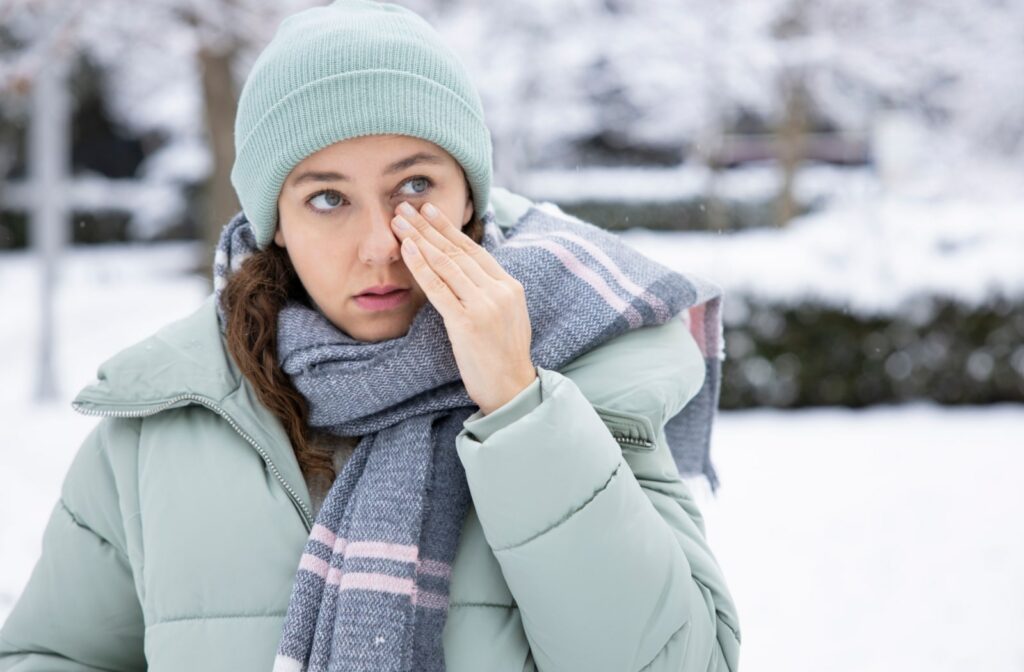The air is cold, and the wind bites your skin, but why does winter also leave your eyes dry and scratchy? Over 16 million Americans have dry eyes. It’s a common condition, and its cause can be diagnosed with an eye exam.
If you regularly deal with dry eyes, you’re right to notice that it may happen more in the winter. Evidence suggests the seasons can impact your eyes. Winter tends to have high winds, low temperatures, and dry air.
The Causes of Winter Dry Eyes
Every time you blink, you’re lubricating your eyes. This action creates a tear film that nourishes the front surface of your eye and protects it from drying out. Dry eyes are caused by your eyes not making enough tears or making tears of poor quality that result in your tear film evaporating too quickly.
Common factors that can result in dry eyes include:
- Aging
- Gender (women are more likely to develop dry eyes)
- Medications such as antihistamines and decongestants
- Medical conditions such as rheumatoid arthritis and diabetes
- Excessive screen time
- Smoky, windy, and dry environments
The cold winter months tend to magnify these factors. The air outside is colder and drier, resulting in your tears evaporating quicker than you can make them. At the same time, you’re cranking up your house’s indoor heating. As a result, your furnace dries out the air, worsening your already dry eyes.
Colds and the flu are also more common in winter. These illnesses typically result in people taking more decongestants to deal with their symptoms, which can further lead to more dry eyes.
Treating Dry Eyes
Dry eye symptoms can be aggravating to deal with, leaving your eyes irritated and red. Some symptoms include:
- A stinging or burning sensation
- Redness
- Blurred vision
- Sensitivity to light
- String eye mucus
- Excess watering (your eye will increase tear production to combat dryness)
An ideal treatment for dry eyes will restore moisture to their surface and increase the quality of your tear film. However, dry eyes can have multiple causes and require a combination of treatments to find relief.
Artificial Tears
Over-the-counter eye drops can manage some cases of dry eye, sometimes called artificial tears. These drops work by mimicking your natural tears to lubricate your eyes better. You should try to apply artificial tears several times throughout the day, but always follow the label since there are many types of eye drops on the market.
If you wear contacts, ensure that you’re purchasing contact-friendly drops, as some may have ingredients that can cause your contact lenses to degrade.
Prescription Medications
Someone who finds themselves requiring more eye drops than the directions recommend might require prescription medications.
If you cannot find relief with over-the-counter artificial tears, contact your optometrist. They may be able to recommend the appropriate medicine, which could be prescribed eye drops or an eye ointment, depending on your needs.
Humidifiers
Ensure that you’re keeping your humidifier clean, as a build-up of bacteria can cause eye irritation. Running your furnace in winter can dry out your air. So a humidifier can be a welcome relief for people whose dry eyes are caused by a lack of humidity.
If you don’t have a humidifier, a pan of water near your heater or radiator can have a similar effect.
Warm Compress
If you’re looking for immediate relief from your dry eye symptoms, a warm compress around the eye area could help. Soak a clean washcloth in gently warmed water and apply to the area around your eye for about 8-10 minutes.
How To Prevent Dry Eyes in Winter
There are steps you can take to potentially prevent your dry eye symptoms from getting worse in winter:
- Lower your indoor heating as much as you can tolerate
- Avoid using hair dryers
- Consider adding more omega-3 fatty acids to your diet
- Wear eye protection, such as wrap-around sunglasses, when you go outside
- Stay hydrated
- Turn your car heaters away from blowing into your eyes
When Are Dry Eyes Too Much?
If you only get dry eyes every so often in winter, it’s usually not a cause for concern. Many people can find relief from dry eyes at home with simple treatments and lifestyle changes.
However, if your symptoms aren’t improving after you’ve treated them, or if you notice a sudden change in your vision, you should consider seeing an optometrist.
Some medical conditions can cause or worsen dry eye symptoms and should be brought to a doctor. These include:
- Sjögren’s syndrome
- Thyroid disease
- Blepharitis
- Lupus
- Vitamin A deficiency
While you can resolve most symptoms of dry eyes in winter at home, you should bring any signs of persistent irritation to your optometrist.
Expert Dry Eye Care
You shouldn’t have to deal with dry eyes and cold weather simultaneously. At Higgins Brothers’ Vision Care, We believe in health-based solutions for dry eye symptoms that let you relax and find comfortable vision. Book an appointment with our expert team today and experience the path to relief.




